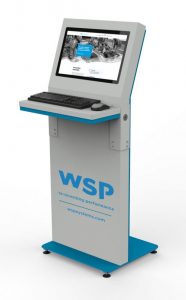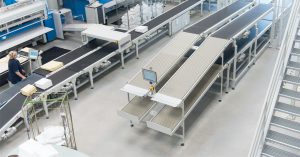Interview of the Month - WRP
The company WSP Systems defines itself as a “system integrator” and focuses its services on the optimisation of internal logistics in laundries. The goal is to ensure highly efficient, but also on-time laundry processing. “For us, the secret of a highly productive laundry is a production flow that works like an integrated chain,” reports Sales Manager Jacco van Riessen. We spoke with him and his colleagues Robert Hardeman and Henk de Bruijn about how they use this approach to make operations more efficient.
WRP: WSP Systems describes itself as a system integrator. What does that mean?

Jacco van Riessen Jacco van Riessen has been with WSP since 2006 and is currently Sales Manager responsible for worldwide sales. Van Riessen has a bachelor’s degree in computer science and has a professional background in control engineering and software engineering.
Jacco van Riessen: In the IT definition, system integration means linking several systems into a single unit. This is also how we understand our task in the laundry. Different systems and processes – starting with the delivery of the goods and ending with their delivery – must be perfectly connected in order to guarantee efficient and punctual laundry processing. If these different systems are optimally integrated in a network, a laundry can operate like a continuous and therefore highly efficient production line. For us, this highly efficient production line is not the sum of its well-functioning parts – machines, employees, logistics, software. On the contrary, these well-functioning parts are the result of an optimal chain. In our view, this approach can achieve major efficiency gains in the laundry. If these individual parts in the operations are not optimally connected with each other, then they function like islands – and the desired efficient production line can therefore not function like a well-oiled chain.

Robert Hardeman represents WSP in southern Germany, Austria and Switzerland. He has eight years of experience in the laundry industry and a bachelor’s degree in business administration.
Robert Hardeman: To integrate a laundry into a perfectly functioning system and then control it optimally, WSP offers the WinWash software. WinWash is a modular platform with which a fully automated production process can be realized. WinWash is a unique operating and control system. It ensures that the linen is processed in the laundry as in an industrial production line with maximum performance and control. In this way, WinWash ensures that, even on hectic days, orders through the processes on time and that they reach the packaging department complete and with maximum punctuality. At the same time, in addition to WinWash and other software solutions, we supply the necessary hardware to ensure optimum internal logistics in a laundry. After all, the laundry must be transported to the individual processing stations efficiently and safely. This, too, is a key precondition for an effective and safe processing operation. That is why the WSP’s portfolio therefore includes solutions to automate the transport of linen through the laundry as completely as possible.
Henk de Bruijn: An example to illustrate these services: We are currently planning a project, it involves the construction of a new laundry. The company had given up its old location and would like to move into the new building with its existing machinery. This machinery includes products from various manufacturers and is to be supplemented with new technology and suitable logistics. The laundry would also like to have its internal logistics designed and supplied by a single provider. Furthermore, all processes in this system should be able to be controlled centrally and with full control. So our task in this project is to integrate existing and new technology from different manufacturers with different control systems into one unit. Then WinWash will control the system so that optimal production can be achieved.
van Riessen: One of our goals is always to be able to communicate as much as possible with the original controls of the machines. Of course, it is also possible to equip existing with new control systems. In the same way, there is always the possibility of implementing interfaces in order to then transfer data and then visualize a complete laundry. The primary goal is always to connect all relevant machines in the laundry to WinWash. So that our software can then optimally control all processes.
de Bruijn: With its solutions, WSP not only increases performance in the existing laundry. It can also completely develop and implement a new laundry. In doing so, WSP is independent of the machine technology and always focuses on the optimal production flow.
WRP: You say this optimal production line is a condition for your parts to function optimally. Why is this perspective important ?

Henk de Bruijn has been with WSP since 2016 and is responsible for the Northern Germany sales area. He has a bachelor’s degree in business administration and logistics and a professional background in the logistics industry.
de Bruijn: Our task is to offer solutions so that a laundry can be operated with maximum productivity. We don’t just focus on the individual machine, the employee or the software, but look at the entire laundry from above. Everything is interrelated. If a parameter changes at a certain point in time – for example, the towel content – this has an impact on the entire system. Many laundries focus their attention on ensuring that each individual machine is running at maximum capacity. But this can be suboptimal for the entire chain. This is because the performance gain in a subsystem or with a single machine can mean a bottleneck in the next process step. Or let’s take another example: In many laundries, the employees at the sorting station determine the sequence of the laundry or the customers in the washing tunnel. At the sorting station, therefore, decisions are sometimes made relatively randomly about all subsequent processes. This is not ideal, of course. After all, what is important for the laundry ? Of course, that the laundry can be delivered to the customer completely and on time. Because this – just like high quality – ensures a high level of customer satisfaction. So it is only logical that the control of the processing of the laundry is oriented to the delivery date, for example. And if the laundry is washed, dried, ironed, etc. at the right time, this also eliminates the need for a large store of unfinished customer containers at the packing stage. Our ideal is to process the laundry just in time, so to speak. WinWash controls this complex task.
Hardeman: That is why WinWash shows the employee at the sorting station on the soiled side that this particular customer must be processed next. This is because WinWash knows that a specific departure time has been set for this customer in the tour schedule. For the software, the starting point is now to control the necessary logistics in such a way that at the end, the finished processed laundry can be on the truck on time. The process is thus controlled from the back – the customer’s departure time – to the front. And it remains a dynamic system and can automatically adapt to new conditions. In this example, let’s further assume that this customer needs ten containers of towels from a pool assortment. Then WinWash first checks how many towels are available in the warehouse. If, for example, there are six containers, then at least four containers of towels must go into processing on the soiled side in order to be able to supply the customer on time.

Operating station for WinWash. WSP’s primary goal is always to connect all relevant machines in the laundry to the system. Subsequently WinWash is to control all processes optimally.
WRP: What does the ideal order processing in this highly efficient laundry look like?
van Riessen: To put it metaphorically: When the orders flow streamlined through the production like on a river. Sometimes the waves on this river are higher, sometimes lower – according to the volume of laundry to be processed. But always the orders flow through the processes without interruptions or abrupt stops. The result is complete customer orders that can be delivered on time. For us, the secret to a highly productive laundry is an optimal production flow.
WRP: How is this production flow achieved ?
de Bruijn: A constant production flow only works with a high level of control. In our view, experience, programs and rules alone will not achieve this. Because we all know that every day in the laundry is different. And decisions have to be made in real time about hundreds of variables that influence each other. This is only possible if you always have the full overview in this constant cycle of controlling, measuring and adjusting, and can influence all these variables centrally from one point. This is what WinWash does. This complexity can hardly be mastered by humans.
WRP: Does WinWash require the wash to be chipped for full functionality ?
Hardeman: No, that is not necessary. WinWash works in many laundries with person-specific laundry or pool-linen without RFID use. Of course, we are seeing more and more chipped laundry in the laundries and have therefore already integrated corresponding functionalities in WinWash. It does not matter with which transponders of the different manufacturers the laundry is equipped, for example to be able to scan a container on the soiled side. We can also, for example, scan the laundry before it is loaded into the washing tunnel or the packages after the ironer and the towelfolders. WinWash completely simulates a laundry and is easy to use. Fault messages and corrections, reports up to individual work instructions for a certain employee at his place – everything is displayed on this central place.
WRP: Besides WinWash, WSP offers a second software. It is called Laundry Dashboard. How does it perform and what is the difference between it and WinWash ?
van Riessen: WinWash is responsible for controlling and operating the complete laundry. Laundry Dashboard is responsible for measuring and visualizing the performance of the laundry. In doing so, the software focuses on three topics: Employees, Machines and Energy. Let’s take laundry employees as an example. Our experience is that they need to be given goals. If they are informed in real time about their current and target performance, then that already automatically means an increase in their performance. With Laundry Dashboard, a percentage is given on the display. This way, the employee on the soiled laundry sorting line has the same goals as the one on the ironer. Laundry Dashboard can also be easily linked to a time recording system. For example, it can automatically record when an employee logs in or out. This in turn can be linked to payroll. There are already laundries that pay a variable wage. For example, a bonus system that is based on the performance of the individual employee. By the way, both solutions – Laundry Dashboard and WinWash – do not necessarily have to be connected. In other words, one software can work without the other.
de Bruijn: Today, around 40 to 50 percent of the total costs of a laundry are personnel costs. And because we as a company are focused on logistics, productivity and efficiency, measuring performance is also a focus for WSP. Laundry Dashboard has a different mission than WinWash, but they both have the same goal: to make the laundry more efficient.
WRP: Can you put numbers to the efficiency of a WSP laundry ?
Hardeman: Well, that always depends on the project in question, of course. But what we can say clearly: If WSP plays a role in the design, realization and optimization of a laundry then the entire laundry organization is perfectly under control. With our solutions, we can always guarantee a more efficient production than before.
WRP: If you look at the German market and here at the laundries: Do they still have a lot of potential in terms of optimal internal logistics?
Hardeman: I think so. If you look at the Netherlands, for example, there is more capacity than demand in some market areas. Therefore, the competition is very intense. Many laundries are also clearly specialized in one market segment, such as hotels, hospitals or residential homes. This is not the case in Germany – at least not in certain markets and regions. Competition in these areas is less intense and more regional. Many medium-sized laundries in Germany are mixed operations with a wide range of customers and laundry products. This makes the task of optimising internal logistics more challenging, but it is still just as solvable.
WRP: What is the difference between WSP and a machine manufacturer when it comes to internal logistics ? Doesn’t the manufacturer also have to manage the topic of internal logistics?

The main focus of WSP Systems is the internal logistics of laundries. Here WSP Systems delivers complete solutions with its software and hardware solutions to optimise these efficiently and powerfully.
de Bruijn: We focus more on employees and logistics than a machine manufacturer. By logistics we mean short distances for employees and also containers, a correct processing sequence of customers, just-in-time production, the completeness of tours and employee productivity. If the machines work well, then the delivery and removal of the laundry is crucial for the laundry’s performance, i.e. the logistics area. This is exactly what we focus on – in contrast to the machine manufacturers. What is also important, is that our solutions are completely independent of brands. We can integrate different manufacturers and combine them into an optimally functioning system.
WRP: Have customers’ tasks changed for WSP Systems in the Corona pandemic?
Hardeman: What we are seeing in the market is that laundries that specialize exclusively in the hotel market are now thinking more intensively about their market segments. But so far, that has had little impact on our day-to-day business. What the pandemic has made laundries much more aware of is their great dependence on individual employees. These have a great amount of know-how and knowledge about the laundry’s processes and structures, about customers, delivery routes, etc. They have a huge impact on the laundry’s day-to-day business. As a result, they are of enormous importance to this operation. If these very special employees drop out – for example due to illness or even poaching – then these companies have a big problem. We have had regular inquiries from laundries in the past as to how they can digitize this employee-bound knowledge, so to speak, and thus make it more available. In order to become less dependent on these highly qualified employees. More and more nationalities and languages are entering the plants. For years now, it has also been increasingly difficult for companies to recruit staff at all. And this makes it more and more problematic for laundries to provide the necessary know-how to be able to guarantee a certain quality, for example. WinWash is a solution here as well. Because the control and operating intelligence of the software makes the laundry increasingly independent of qualified personnel.
de Bruijn: It should also not be the case, for example, that the laundry’s performance is dependent on a particular shift manager. That is also something that can be observed in many companies. We say that you can automate this in order to be able to guarantee a constant performance – regardless of the daily form of the production manager.
WRP: What concepts / solutions is WSP currently working on, what is in the pipeline of the development department ?
Hardeman: We invest in new functionalities for our solutions every year. In doing so, we also try to learn from other industries. For example, it is already more than planned that we extend our central task area of internal logistics in the direction of the external logistics of the laundries. For example, customers can then use portals to find out where their laundry is currently located. Or see if they can order more laundry, etc. We are currently working on our new Lean Laundry concept for processing flat linen and residents’ laundry. The level of automation in Lean Laundry is very high due to the technology used as well as the level of organization of the laundry. The goal of Lean Laundry is a highly automated and thus employee-free production. This is the ideal. In Lean Laundry, the new technologies are used in an optimal way. The Lean Laundry concept is an overall concept. Maximum efficiency and operational excellence – that is, the ability of a company to continuously optimize its processes and systems across the entire value chain – are a combination of organization and technology here.
van Riessen: Of course, the personnel-free laundry is still a future dream today. This concept can already be implemented to the extent that laundry is in the hands of employees as little as possible in the current Lean Laundry.

